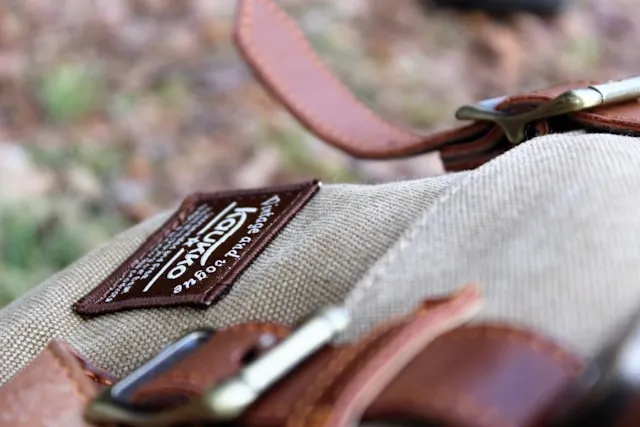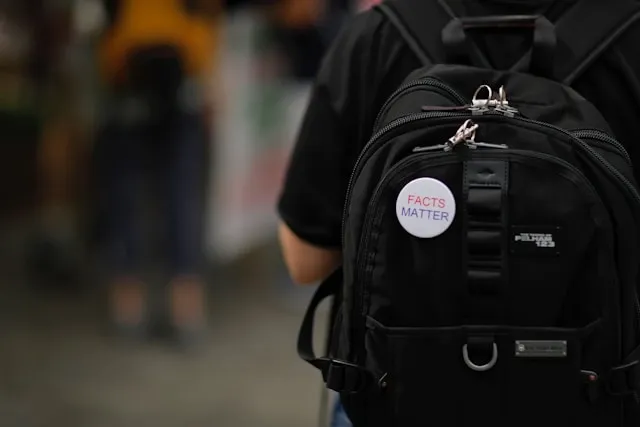How To Sew A Patch On A Backpack
Sewing patches onto backpacks is a great option for adding character and a personal touch. In this post, we delve into the step-by-step processes for different backpack materials for an effective adhesion. Whether you’re experienced with a needle or a total novice, our guide will help you achieve a good finish that stands the test of time. Your patches will stay securely attached as you go about your business.

Key Takeaways
- Sewing patches on backpacks is a great way to alter their character or personalize with unique designs to express your personality.
- ItÔÇÖs important to prepare thoroughly before sewing patches onto backpacks, including gathering materials and prepping the fabric surface.
- Follow a step-by-step process and pay attention to detail when sewing, accounting for the specific needs of your backpack material.
- Common alternatives to sewing patches onto backpacks include iron-on and safety pin patches, as well as using fabric glue or Velcro backings.
- Follow best practices and avoid common pitfalls to get the best possible results when sewing patches onto your backpack.
- We supply high-quality custom patches in a range of materials and with various backing options so that you can create your own design to add to your backpack.
Preparation Required For Sewing Patches Onto Backpack
The actual sewing process is the most important part of adding patches to your backpack, but good preparation is crucial to get the best possible result. You want to apply patches that add personality and color to your backpack, and you want them to stand the test of time. This means taking your time to carry out the necessary steps to prepare for the process.
Before sewing patches onto your backpack, gather together the required materials:
- Your patch
- A needle (or needles)
- Sturdy thread
- Pins
As part of your preparation for how to put patches on a backpack, you will need to identify where you want it to go. Clean the area so that it is dirt-free for optimal adhesion then use pins to secure the patch in place.
Once you have prepped the bag and your equipment, you are ready to begin the stitching to secure the patch onto your backpack.

How To Sew Patches On Nylon Backpacks
Here is a simple step-by-step process for how to sew patches on a backpack made from nylon. We have included a few specific considerations for the material:
- Choose the location where the patch will go and pin it in place, ensuring good alignment.
- Use nylon thread and a sewing machine, or a strong hand-sewing needle suitable for nylon fabric.
- Sew around the patch edges using a straight or zigzag stitch. Be careful not to stretch the nylon whilst sewing as this will warp the backpack’s shape.
- Tie knots in the thread ends on the inside of the backpack before trimming away excess thread.
You can test the patch by pulling gently on the edges - reinforce as necessary. Our custom patches for backpacks allow complete freedom to create the perfect patch you can then sew onto your backpack.
How To Sew On Patches To Leather Backpack
Sewing patches on backpacks made from leather requires careful handling to protect the material. You will want to consider different patch fabrics, so do some research into woven vs embroidered patches and consider other options.
Here’s the step-by-step process:
- Choose where you want the patch to go on the backpack and secure it in place with small clips or tape.
- Prepare a leather needle and strong thread suitable for the fabric.
- Using a durable backstitch or saddle stitch, sew meticulously along the outside edges of the patch. Start from the inside and maintain even stitches throughout.
- Knot and secure the thread ends on the inside of the backpack.
Again, you can test the adhesion by gently pulling the edges and reinforcing where needed. Leather can be prone to tearing if not handled with care, so some might choose to use fabric glue in addition to sewing for a more robust adhesion.
Sewing Patches Onto Other Backpack Types
When exploring how to sew patches onto a backpack made from a material other than nylon or leather, it’s important to accommodate the specific characteristics of the material in question. Here are a few options and suggestions for a good outcome:
- Canvas: Use a heavy-duty needle and strong thread that can handle the thickness of the material. A light adhesive may be helpful before sewing for a stronger attachment.
- Polyester: Choose a polyester thread that matches the fabric color for a seamless application. Use fabric-friendly adhesive tape to secure the patch during sewing.
- Denim: A denim needle and durable thread are necessary for sewing onto denim. Make sure the bag is pre-washed and dried.
Whatever material you use, explore different types of stitches to find what will work best for your needs. And consider testing the stitches on a scrap piece of fabric beforehand to establish the optimal stitch length.
Creative Ideas For Sewing Patches Onto Backpacks
Sewing patches onto backpacks is a creative solution for personalizing and adding character to your gear. Just like with sewing patches onto a jacket, it allows you to display certain designs and information, or share something about your personality. With our custom patches, you choose the size, shape, color, and bespoke design of your patches to get the look you want.
Here are some creative ideas to think about for sewing patches onto your backpack:
- Arrange the patches in themed clusters, like favorite bands, hobby-related designs, and travel destinations.
- Mix and match patch shapes and sizes for visual interest.
- Create a cohesive aesthetic with patches that share a color palette.
- Experiment with different embroidery stitches around patches to enhance durability and add detail.
- Sew patches along the backpack’s seams or edges for a subtle, stylish touch.
Layering patches or combining them with things like buttons and fabric paint can give your backpack a unique character.

How To Sew Flag Patches On Backpacks
Flag patches are a popular choice for backpacks to display your patriotism or showcase your favorite travel destinations. Placement is key for visibility and aesthetic appeal, so here are some tips for sewing flag patches onto backpacks:
- Choose a prominent location like the upper center or front pocket.
- Take your time to ensure proper centering and alignment for a polished look.
- Secure the patch in place with pins before sewing to prevent shifting.
- Select a strong thread in colors that complement the patch and backpack.
- Sew with a tight, secure stitch like a straight or zigzag stitch around the edges.
Choose a patch made from a material that will endure outdoor use and frequent handling for a long-lasting solution.
Create the perfect custom flag patches for your backpack
Whether for traveling or simply to display your patriotism, create high-quality custom flag patches with our service to get the right style for your needs.
Alternatives To Sew-On Patches For Backpacks
Sewing patches onto backpacks is a durable solution, but there are alternative attachment methods to explore. Iron-on patches are a convenient option, using a heat-activated adhesive for quick customization that may not be quite as durable as the sew-on method. Safety pin patches are another one, offering a temporary option, or one that delivers a unique look.
Other options include:
- Fabric glue
- Velcro
- Peel-and-stick patches
You need to consider the longevity and ease of each application method, then weigh that up against your requirements. When you order custom name patches for backpacks from us, you have an array of backing options to get the attachment method that works for you. Explore what’s available and create the backpack patch that delivers the aesthetic and practical characteristics for you.
Iron-On Patches
Patches with heat-activated adhesives offer a straightforward solution for customizing your backpack, though the results may not be quite as durable as sewing. Here’s how to iron on a patch to a backpack:
- Place the patch on the desired spot of your backpack, adhesive side down.
- Cover with a thin cloth or parchment paper to protect the backpack from direct heat exposure.
- Set the iron to the appropriate temperature as indicated in the manufacturer instructions then apply even pressure to the patch for the required time.
- Check for a strong adhesion once it has cooled, and repeat if necessary.
The advantages of iron-on patches include swift application and no need for any sewing skill. But it may be a less durable solution in the long-term than sewing, particularly for a heavily-used item like a backpack.
Safety Pin Patches
We also supply high-quality safety pin backings for patches, enabling you to pin them to your backpacks like a badge. This is a versatile method, but it will probably require some occasional reattachment. The process for this is very simple:
- Think carefully about where you want your patch to go.
- Secure the safety pin backing to the backpack fabric, aiming for optimal alignment and orientation.
This creates a unique look for your backpack, and one of the key advantages is that the patch can be easily removed for washing or changing the bag’s look. However, the main disadvantage is that the patch can shift during use, and it may even become detached without you realizing. You will need to periodically check and readjust to maintain the optimal aesthetic.
You can design your own safety pin patches with us for a quick solution that displays the design you want on your bag, always crafted to the highest standards.
Top Tips For How To Make Patches Stay On Backpacks
Whether you educate yourself on how to make patches for backpacks or use our custom service to get the aesthetic you want, you will want to sew patches onto your backpack that stand the test of time. Ensuring maximum durability requires meticulous attention to detail during the sewing process.
Here are some tips to achieve maximum longevity:
- Use a strong, high-quality thread that matches the patch and the backpack.
- Double-thread your needles, as this adds strength and enables multiple passes through the patch and backpack.
- Knot the thread tightly at both ends so that it cannot unravel when in use.
- It may be helpful to apply a thin layer of fabric glue to the back of the patch before sewing for an even stronger bond.
- Stitch around the edges of the patch to ensure it is firmly anchored in place.
- After sewing, give the patch edges a gentle tug to test stability, and reinforce as necessary.
- Regularly inspect and reinforce patches as required to ensure their secure attachment remains over time.
Our custom patches are truly built to last, with high-quality attachment methods and detailed instructions for application. Follow the tips listed above and you will get good results for a durable adhesion to your bag.

Get patches optimized for attaching to backpacks
Our custom patches for backpacks are made with materials and attachment methods that are proven for backpacks. Work with us to create your backpack flag patches.
Create your patches hereCommon Mistakes To Avoid With Sewing Patches On Backpacks
When sewing patches onto backpacks, there are various common mistakes that you should avoid if you want to protect the quality and longevity of the bond. Here are the key mistakes you should try to steer clear of:
- Using weak thread: A strong, durable thread is important, as weak thread can easily break and cause the stitches to come loose. Pay attention to the color of the thread as well to ensure a good match with the patch and backpack.
- Skipping knots: If you don’t knot your thread securely after each pass, your stitching is liable to unravel if the thread is tensioned or snagged.
- Ignoring the fabric type: Different fabrics require different considerations when it comes to threads and sewing. Choose the right needle, thread, and stitching style for nylon, leather, canvas, or other backpack materials.
- Rushing: You should take your time with the process of how to sew patches onto a backpack. A rushed job can lead to irregular stitching, missed sections, or accidental damage to the backpack itself.
- Neglecting placement: For best results, you should measure and mark the patch placement before you begin sewing it in place. Misplaced or misaligned patches look messy and may need to be removed and resewn.
- Not reinforcing edges: After checking the bond, reinforce around the edges of the patch with a zigzag stitch to strengthen its attachment and prevent fraying.
When you order your custom patches from us, avoid these common mistakes for best results when applying. By adhering to best practices, you will ensure a secure and neat attachment that offers longevity and aesthetic appeal.
Frequently Asked Questions About How To Sew A Patch On A Backpack
How Do You Prepare To Sew Patches On Backpacks?
You should prepare for sewing by ensuring you have gathered the right materials, including an appropriate needle and thread. Identify the optimal patch placement and pin it in place, ensuring the backpack is clean and free of wrinkles.
What Are The Common Alternative Attachment Methods To Sew-On Backpack Patches?
While sewing patches onto backpacks is a durable and reliable solution, there are alternatives. Iron-on and safety pin patches are common choices, as are Velcro and peel-and-stick patches. You could also use fabric glue to secure yours in place.